Analysis and evaluation of capital adequacy in Latvian banking system
DOI:
https://doi.org/10.12775/CJFA.2016.006Słowa kluczowe
Capital adequacy, Risk adjusted assets, Credit risk, Market risk, Operational risk, Buffer capitalAbstrakt
Regulation of banking activity under economic insecurity conditions is one of key problems in our times and is acquiring a particular importance both for banks themselves and their shareholders and also for customers and depositors. Instability of economic situation gives birth to increasing risks faced by world banking system. And therefore in order to ensure reliable operation of commercial banks and prevent their vulnerability to economic insecurity, the supervisory bodies are continuously improving the methods of and approaches towards the management of bank risks accenting a paramount importance of own capital adequacy. A problem of how much capital Latvian commercial banks need to cover their risks remains one of most important in regulation and assessment of banking activity. Meanwhile, the principal direction to improve the capital adequacy ratio is the growth in its flexibility when determining the value of risks inherent to various bank organisations. In the present research authors carry out the analysis of risks inherent in activity of Latvian commercial banks, indentifies the risk pattern within own capital of banks, discovers factors having impact upon the risk pattern as well as estimates the amount of capital necessary to cover risks in various groups of commercial banks. Hypothesis – Stability of a banking system depends on the level of sufficiency of a bank capital. The aim of the research: Evaluation of capital adequacy of Latvian commercial banks and correspondence of capital adequacy calculations to Basel Committee on Banking Supervision rules based on analysis of financials statements, identification of capital adequacy problems and developing recommendations on improving bank capital adequacy according to the effective and the planned Basel Committee on Banking Supervision requirements.
Bibliografia
Barclays Capital (2010). Basel III Final Document – What’s New.
Basel Committee on Banking Supervision, (2004), International Convergence of Capital Measurement and Capital Standards: A Revised Framework. Switzerland: Basel Commitee On Banking Supervision. https://www.bis.org/publ/bcbs128.pdf (accessed: 10.03.2016).
Basel Commitee on Banking Supervision, (2010). Basel III: A global regulatory framework for more resilient banks and banking systems, Switzerland: Basel Commitee on Banking Supervision. https://www.bis.org/publ/bcbs189_dec2010.pdf (accessed: 12.02.2016).
Basel Commitee on Banking Supervision, (2010). Results of the comprehensive quantitative impact study, Switzerland: Basel Commitee on Banking Supervision. https:// www.bis.org/publ/bcbs186.pdf, (accessed: 12.02.2016).
Basel Commitee on Banking Supervision, (2013). About Basel. http://www.bis.org/ bcbs/about.htm (accessed: 8.01.2016).
Bank for International Settlements, Committee on Payment and Settlement Systems, (2003). A glossary of terms used in payments and settlement systems. Switzerland: Bank for International Settlements. https://www.bis.org/publ/cpss00b.pdf (accessed: 8.01.2016).
Cornford, A., (2010). Revising Basel 2: The Impact of the Financial Crisis and Implications for Developing Countries. In: G-24 Discussion Paper Series, UNITED NATIONS CONFERENCE ON TRADE AND DEVELOPMENT. New York and Geneva, June 2010.
European Parliament and Council Directive 2002/87/EK dated by 20.07.2011.
Ferguson, R.W., (2003). Capital standards for banks: the evolving Basel accord, Federal reserve bulletin. www.federalreserve.gov/pubs/bulletin/2003/0903lead.pdf (accessed: 12.02.2016).
Financial Commission of Market and Capital (FCMC). Legislations documents, statistics of the credit institutions, annual reports. http://www.fktk.lv (accessed: 12.02.2016).
Greuning, H., & Brajovic Bratanovic, S., (2009). Analyzing banking risk: a framework for assessing corporate governance and risk management. Washington: World Bank.
Kudinska. M., & Konovalova. N., (2012). The Analysis of Bank Capital Adequacy: the Case of Latvia, Journal of Business Management, No. 6.
Balthazar L., (2006). From Basel 1 to Basel 3. Great Britain: PALGRAVE MACMILLAN. www.palgraveconnect.com/doifinder/10.../978023050117.
Moody’s Analytics, (2011. – 2012.). From Basel II to Basel III.
PWC, (2011). Risk & Capital Management under Basel III, www.pwc.com/gx /en/banking.../ basel-iii-programme.pdf (accessed: 07.01.2016).
Rose, S.P., (2002). Commercial Bank Management. McGraw-Hill Higher Education.
Saksonova, S., (2006). Banku darbība. Riga: Latvian Association of Commercial Banks counseling and training center.
Schooner, H.M., & Taylor, M., (2009). Regulation of Global Banking: Principles and Policies. Chicago: Academic Press.
Pobrania
Opublikowane
Jak cytować
Numer
Dział
Statystyki
Liczba wyświetleń i pobrań: 590
Liczba cytowań: 0



